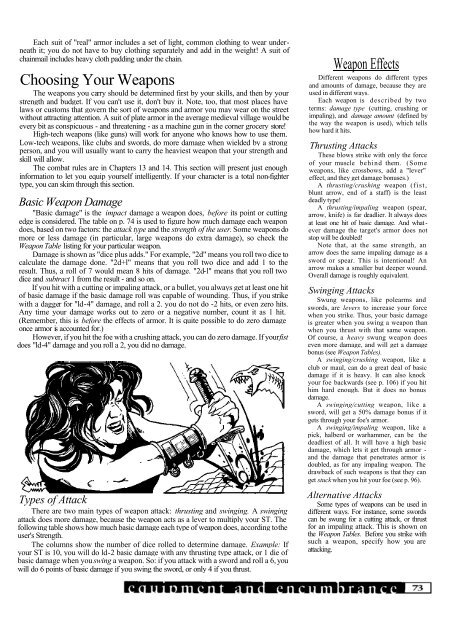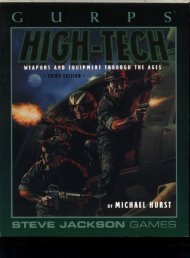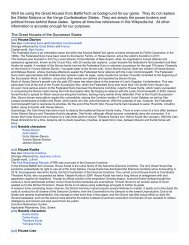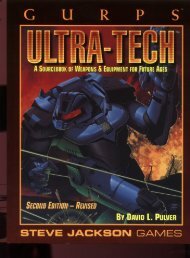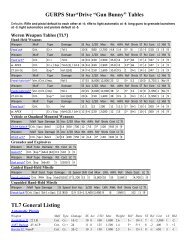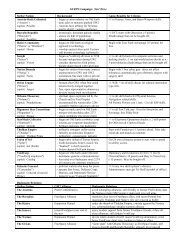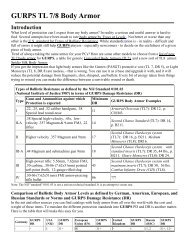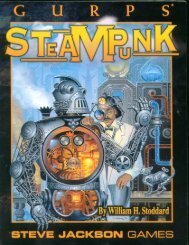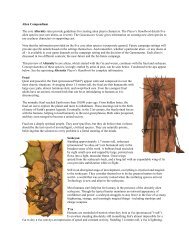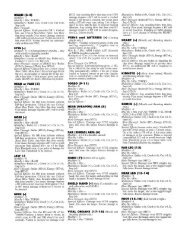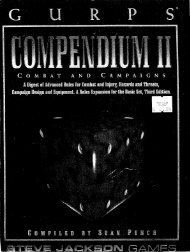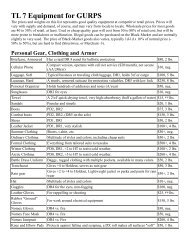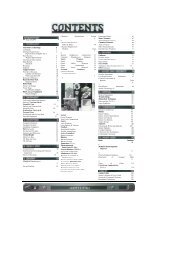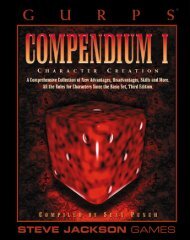Each suit of "real" armor includes a set of light, common clothing to wear underneathit; you do not have to buy clothing separately and add in the weight! A suit ofchainmail includes heavy cloth padding under the chain.Choosing Your WeaponsThe weapons you carry should be determined first by your skills, and then by yourstrength and budget. If you can't use it, don't buy it. Note, too, that most places havelaws or customs that govern the sort of weapons and armor you may wear on the streetwithout attracting attention. A suit of plate armor in the average medieval village would beevery bit as conspicuous - and threatening - as a machine gun in the corner grocery store!High-tech weapons (like guns) will work for anyone who knows how to use them.Low-tech weapons, like clubs and swords, do more damage when wielded by a strongperson, and you will usually want to carry the heaviest weapon that your strength andskill will allow.The combat rules are in Chapters 13 and 14. This section will present just enoughinformation to let you equip yourself intelligently. If your character is a total non-fightertype, you can skim through this section.<strong>Basic</strong> Weapon Damage"<strong>Basic</strong> damage" is the impact damage a weapon does, before its point or cuttingedge is considered. The table on p. 74 is used to figure how much damage each weapondoes, based on two factors: the attack type and the strength of the user. Some weapons domore or less damage (in particular, large weapons do extra damage), so check theWeapon Table listing for your particular weapon.Damage is shown as "dice plus adds." For example, "2d" means you roll two dice tocalculate the damage done. "2d+l" means that you roll two dice and add 1 to theresult. Thus, a roll of 7 would mean 8 hits of damage. "2d-l" means that you roll twodice and subtract 1 from the result - and so on.If you hit with a cutting or impaling attack, or a bullet, you always get at least one hitof basic damage if the basic damage roll was capable of wounding. Thus, if you strikewith a dagger for "ld-4" damage, and roll a 2. you do not do -2 hits, or even zero hits.Any time your damage works out to zero or a negative number, count it as 1 hit.(Remember, this is before the effects of armor. It is quite possible to do zero damageonce armor is accounted for.)However, if you hit the foe with a crushing attack, you can do zero damage. If your fistdoes "ld-4" damage and you roll a 2, you did no damage.Types of AttackThere are two main types of weapon attack: thrusting and swinging. A swingingattack does more damage, because the weapon acts as a lever to multiply your ST. Thefollowing table shows how much basic damage each type of weapon does, according to theuser's Strength.The columns show the number of dice rolled to determine damage. Example: Ifyour ST is 10, you will do ld-2 basic damage with any thrusting type attack, or 1 die ofbasic damage when you swing a weapon. So: if you attack with a sword and roll a 6, youwill do 6 points of basic damage if you swing the sword, or only 4 if you thrust.Weapon EffectsDifferent weapons do different typesand amounts of damage, because they areused in different ways.Each weapon is described by twoterms: damage type (cutting, crushing orimpaling), and damage amount (defined bythe way the weapon is used), which tellshow hard it hits.Thrusting AttacksThese blows strike with only the forceof your muscle behind them. (Someweapons, like crossbows, add a "lever"effect, and they get damage bonuses.)A thrusting/crushing weapon (fist,blunt arrow, end of a staff) is the leastdeadly type!A thrusting/impaling weapon (spear,arrow, knife) is far deadlier. It always doesat least one hit of basic damage. And what -ever damage the target's armor does notstop will be doubled!Note that, at the same strength, anarrow does the same impaling damage as asword or spear. This is intentional! Anarrow makes a smaller but deeper wound.Overall damage is roughly equivalent.Swinging AttacksSwung weapons, like polearms andswords, are levers to increase your forcewhen you strike. Thus, your basic damageis greater when you swing a weapon thanwhen you thrust with that same weapon.Of course, a heavy swung weapon doeseven more damage, and will get a damagebonus (see Weapon Tables).A swinging/crushing weapon, like aclub or maul, can do a great deal of basicdamage if it is heavy. It can also knockyour foe backwards (see p. 106) if you hithim hard enough. But it does no bonusdamage.A swinging/cutting weapon, like asword, will get a 50% damage bonus if itgets through your foe's armor.A swinging/impaling weapon, like apick, halberd or warhammer, can be thedeadliest of all. It will have a high basicdamage, which lets it get through armor -and the damage that penetrates armor isdoubled, as for any impaling weapon. Thedrawback of such weapons is that they canget stuck when you hit your foe (see p. 96).Alternative AttacksSome types of weapons can be used indifferent ways. For instance, some swordscan be swung for a cutting attack, or thrustfor an impaling attack. This is shown onthe Weapon Tables. Before you strike withsuch a weapon, specify how you areattacking.
Weapon TablesA "Weapon Table" is a list of weapons,showing damage, weight, cost and otherinformation. The Weapon Tables are in theCharts & Tables section.Each game world released for <strong>GURPS</strong>will include the appropriate WeaponTables, armor lists, etc., for that world.Weapon QualityThe Weapon Table prices assumeweapons of "good" quality. Fine qualityweapons may be made for Good qualityprices at TL7+ due to improvements in metallurgy.The qualities and relative prices are:Swords. Swords are very costly. This isbecause, especially at low tech levels, it isno mean feat to temper a piece of steel tomake it thin, light, yet strong and capableof holding an edge! Thus, there is a widerange of quality among knives and swords.A cheap sword (bronze or poor steel)has a 2/3 chance of breaking when it parriesa very heavy weapon, and is more likely tobreak on a critical miss. But it costs only40% of the price shown in the table.A good sword is as listed in the table. Ithas a 1/3 chance of breaking when it parriesa very heavy weapon (see pp. 99 and 111).All weapons mentioned will be of thisquality unless specified otherwise.A fine sword has only a 1/6 chance ofbreaking when it parries a very heavyweapon. It holds a better edge, so it does +1basic damage. It costs 4 times the listed price.A very fine sword will not break on aparry. It does +2 damage. It costs at least20 times the listed price - and very fineswords are not available in most places!Axes, polearms, and other cutting andimpaling weapons of fine quality areunusual (because the armorer must, ineffect, use sword steel). Therefore, theycost 10 times the listed price. They also do+1 basic damage. Very fine and cheapweapons of this type are rarely made.Maces and other crushing weapons maybe of fine quality; they cost three times thelisted amount and resist breakage, asabove, but do no extra damage.Bows and crossbows of fine quality willshoot 20% farther than normal weapons.They cost four times the listed amount.Guns, beam weapons, etc. of fine qualitywill be more beautiful, or more accurate, orboth, but usually have no extra range ordamage. Cheap guns are often available;cost depends on the game world (generically,60% of listed price). They are less accurate (aminus to Acc of 1 to 10) and more likely tomalfunction in upsetting ways.Magical weapons are covered inChapter 19, Magic. They are more likely tovary in Power than in physical quality.Strength ofattackerThrusting attack (fist,spear, etc.)1 ld-9 ld-92 ld-8 ld-83 ld-7 ld-74 ld-6 ld-65 ld-5 ld-56 ld-4 ld-47 ld-3 ld-38 ld-3 ld-29 ld-2 ld-110 ld-2 1d11 ld-1 ld+112 ld-1 ld+213 1d 2d-l14 1d 2d15 ld+1 2d+l16 ld+1 2d+217 ld+2 3d-l18 ld+2 3d19 2d-l 3d+l20 2d-l 3d+2See p. 248 for a chart covering higher levels of ST.Swinging attack(sword, club, etc.)Listing <strong>Basic</strong> Damage On Your Character SheetOn the table above, find your Strength. Read across to the two types of basic damagethrusting and swinging. Copy these two numbers onto your Character Sheet. The "<strong>Basic</strong>Damage" box is just below the "ST/Fatigue" box, since basic damage is based on ST.You will refer to this whenever you need to figure how much damage you do with aprimitive weapon. The specific weapon you use will affect this number - a greataxedoes more damage than a shortsword. See p. 75.Damage Types and Damage BonusWeapons do three basic types of damage: impaling, cutting and crushing. Impalingweapons are those that strike with a sharp point. Cutting weapons strike with an edgeCrushing weapons strike with a blunt surface. So, for instance, a fist or club is a crushingweapon. A spear or arrow is an impaling weapon, a sword or axe is a cutting weapon.Cutting and impaling weapons are more effective on flesh than on armorTherefore, they do bonus damage - but only if they penetrate the armor.When you hit with a cutting weapon, all damage that gets through the target's armor(and other Damage Resistance) is increased by 50%, rounded down. Suppose you strikewith a sword and do 8 points of damage, 5 of which get through the armor. Half of 5 is2,5. So the victim takes an extra 2 points of damage, for a total of 7.When you hit with an impaling weapon, the damage that gets through the armor isdoubled. If you hit your foe with a spear, and 5 points of damage get through the armor hetakes 10 "hits" of injury!Thus, impaling weapons are deadly against unarmored targets. For a well-armoredtarget, a heavy, swung weapon (an axe or maul) may be best, because it can overcome theDR of the armor and get through to the wearer!Bullets are a special case; different types of bullets have different damage multipliers.Dum-dums, for instance, are treated as impaling because they do terrible damage to flesh.Armor-piercing bullets have a high basic damage, to punch through armor, but the damagethat gets through the armor is halved because the bullet cuts right through the targetwithout mushrooming.
- Page 3 and 4:
17. FLIGHT.........................
- Page 5 and 6:
Materials Needed for PlayThe GURPS
- Page 7 and 8:
WHAT IS ROLEPLAYING?A roleplaying g
- Page 9 and 10:
Character TypesThere are no "charac
- Page 12 and 13:
Four numbers called "attributes" ar
- Page 14 and 15:
You are free to set the physical ap
- Page 16 and 17:
REPUTATIONSome characters are so we
- Page 18 and 19:
These are character traits that are
- Page 20 and 21:
Legal Enforcement Powers 5, 10 or 1
- Page 22 and 23: Rapid Healing5 pointsThis advantage
- Page 24 and 25: A minor deity as Patron to a travel
- Page 26 and 27: ReputationVariable (see p. 17)Socia
- Page 28 and 29: Lame-15,-25, or -35 pointsYou have
- Page 30 and 31: Bad Temper-10 pointsYou are not in
- Page 32 and 33: Dyslexia-5 or -15 pointsYou have a
- Page 34 and 35: Pacifism-15 or -30 pointsYou are op
- Page 36 and 37: Shyness-5,-10,-15 pointsYou are unc
- Page 38 and 39: You have a significant responsibili
- Page 40 and 41: A "quirk" is a minor personality tr
- Page 42 and 43: SpecializingRequired Specialization
- Page 44 and 45: MEANING OF SKILL LEVELSSo you have
- Page 46 and 47: Teamster (Mental/Average)Defaults t
- Page 48 and 49: Skiing (Physical/Hard)Defaults to D
- Page 50 and 51: Guns/TL (Physical/Easy)Defaults to
- Page 52 and 53: Any of these skills can be self-tau
- Page 54 and 55: Levels of Language SkillThis table
- Page 56 and 57: Most outdoor skills can be learned
- Page 58 and 59: PSIONIC SKILLSThese are special men
- Page 60 and 61: Forensics/TL (Mental/Hard)Defaults
- Page 62 and 63: Few Hundred Acres: Knowledge of far
- Page 64 and 65: Many skills in this category are ta
- Page 66 and 67: Lockpicking/TL (Mental/Average) Def
- Page 68 and 69: Gunner/TL See Combat Skills, p. 50M
- Page 70 and 71: Now you need to decide what equipme
- Page 74 and 75: Listing Weapons On Your Character S
- Page 76 and 77: Recording Encumbrance on YourCharac
- Page 78 and 79: Passive Defense. The first blank is
- Page 80 and 81: The longer (and the more skillfully
- Page 82 and 83: When you improve a skill, the cost
- Page 84 and 85: Not all the advantages and disadvan
- Page 86 and 87: But remember . . . some skills have
- Page 88 and 89: ClimbingTo climb anything more diff
- Page 90 and 91: SwimmingThe Swimming skill (p. 49)
- Page 92 and 93: WILL ROLLSWhen a character is faced
- Page 94 and 95: The GURPS combat system is designed
- Page 96 and 97: WaitDo nothing unless a foe comes w
- Page 98 and 99: You may only block one attack per t
- Page 100 and 101: Missile WeaponsMissile weapons are
- Page 102 and 103: At the end of your move, if you hav
- Page 104 and 105: The rules for attacking a foe are e
- Page 106 and 107: tell you how long it will take. In
- Page 108 and 109: You may normally parry only one att
- Page 110 and 111: CLOSE COMBATUsing the Move, Step an
- Page 112 and 113: (adjusted) ST! Note that a shield h
- Page 114 and 115: Ranged Weapon StatsFor each ranged
- Page 116 and 117: second. On the table, this rounds u
- Page 118 and 119: If you are using the "hit location"
- Page 120 and 121: Removing or folding the stock of a
- Page 122 and 123:
After the initial "freeze" ends, ea
- Page 124 and 125:
ATTACKING INANIMATE OBJECTSThere ar
- Page 126 and 127:
This subtraction will mostoften aff
- Page 128 and 129:
Psionic healing (p. 175) and magica
- Page 130 and 131:
DrowningSee the rules for Swimming,
- Page 132 and 133:
protects completely. Toughness prot
- Page 134 and 135:
Resolving mounted or vehicular comb
- Page 136 and 137:
Using Ranged Weapons From Horseback
- Page 138 and 139:
This section covers special rules f
- Page 140 and 141:
HT: Health and Hit PointsFor a roug
- Page 142 and 143:
Swarm AttacksA group of small creat
- Page 144 and 145:
Encumbrance and MovementEncumbrance
- Page 146 and 147:
A critical miss means the energy co
- Page 148 and 149:
oll will not end the spell, but the
- Page 150 and 151:
If the subject makes the resistance
- Page 152 and 153:
won't work. If anyone but the caste
- Page 154 and 155:
ANIMAL SPELLSThese are the spells r
- Page 156 and 157:
If the summoning spell is repeated,
- Page 158 and 159:
Cost: 1 for an object up to the siz
- Page 160 and 161:
Armor EnchantmentsThese spells work
- Page 162 and 163:
AuraInformationShows the caster a g
- Page 164 and 165:
Psionics, or "psi" abilities, are p
- Page 167 and 168:
GlossaryESP - Extra-Sensory Percept
- Page 169 and 170:
Psionics and MagicMagic and psionic
- Page 171 and 172:
PSYCHOKINESISThis power covers movi
- Page 173 and 174:
Pside EffectsPsi skills can have "s
- Page 175 and 176:
Limitations(Continued)Fickle: varia
- Page 177 and 178:
Player-Made MapsWhenever the player
- Page 179 and 180:
Predetermined ReactionsCertain NPCs
- Page 181 and 182:
Dealing with the PlayersArgumentsAs
- Page 183 and 184:
Time Use SheetsThe Time Use Sheet (
- Page 185 and 186:
Weapons and Armor0. Fists and stone
- Page 187 and 188:
Weather(Continued)WindWinds from ga
- Page 189 and 190:
Gold and SilverA traditional assump
- Page 191 and 192:
JobsThe jobs available in each game
- Page 193 and 194:
Job (Prerequisites), Monthly Income
- Page 195 and 196:
Sooner or later, every GM wants to
- Page 197 and 198:
Features of a GoodAdventureA good a
- Page 199 and 200:
World-BuildingA game world is a com
- Page 201 and 202:
CRITICAL HIT TABLEAll doublings or
- Page 203 and 204:
When the players meet an NPC whose
- Page 205 and 206:
Weapons are listed in groups, accor
- Page 207 and 208:
MODERN AND ULTRA-TECH WEAPONSWeapon
- Page 209 and 210:
ANCIENT/MEDIEVAL ARMORUse this tabl
- Page 211 and 212:
FANTASY/MEDIEVAL EQUIPMENTThe follo
- Page 231 and 232:
After eight printings of the GURPS
- Page 233 and 234:
of Divination should match the "fla
- Page 235 and 236:
Minor disadvantage: -5 points. Agai
- Page 237 and 238:
Whether through an accident of birt
- Page 239 and 240:
Note that this disadvantage is inco
- Page 241 and 242:
SKILLSARTISTIC SKILLSVideo Producti
- Page 243 and 244:
traders, and chess-like games are c
- Page 245 and 246:
If, during an adventure, a philosop
- Page 247 and 248:
VITAL ORGANSThese are optional rule
- Page 256 and 257:
INSTANT CHARACTERSThis quick refere


